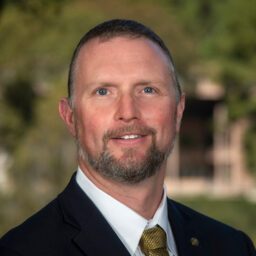
Shaping the Future of Particle Physics
To answer some of the biggest questions about the universe — its origin, structure, and ultimate fate — scientists must first understand its tiniest, most fundamental particles and forces. The field of particle physics, at its most basic, uses the language of physics and mathematics to describe these basic building blocks of the universe. Hertz Fellow Cameron Geddes is working to gain that understanding.
Over the last year, a panel of physicists — with broader input from scientists around the globe — has assembled a new plan for how to move particle physics forward over the next ten to twenty years. Geddes, the director of Accelerator Technology and Applied Physics at Lawrence Berkeley National Laboratory, was part of that panel, dubbed the Particle Physics Project Prioritization Panel (or P5).
“It was tremendously inspirational and educational to serve on P5,” says Geddes. “This plan is designed to guide scientists’ research, guide funding agencies and Congress, and help implement an overall vision for the future of particle physics.”
In the early 2000s as a Hertz Fellow at the University of California, Berkeley, Geddes worked on designing some of the earliest particle accelerator systems that used intense lasers to accelerate particles within plasma. At the time, this was a relatively novel and unproven idea; Geddes says he likely wouldn’t have received funding for the project and wouldn’t have been able to pursue it without his Hertz Fellowship.
The research paid off, however. Geddes and his collaborators showed how they could create high-energy waves in plasma to accelerate particles — a result initially met with skepticism but now embraced and used widely.
Geddes has since developed smaller and more affordable accelerators than the billion-dollar machines found at national laboratories, with the goal of providing precise x-ray sources for medical and security applications.
“This kind of research encompasses tool development with many applications, but I’m also fascinated by the science of the accelerator itself,” he says. “There are questions about how you control a laser with high intensity and get particles into a plasma structure in a controlled way.”
As his career at Berkeley Lab progressed, Geddes found himself drawn to leadership roles. He loved collaborating with other scientists, exploring a broad range of topics within particle physics, and mentoring students throughout their career paths.
“I had a few early opportunities to develop big proposals at Berkeley Lab and I found it really rewarding to be able to talk to broad communities about how to translate particle physics into applications,” he says.
In 2019, Geddes became the deputy director for experiments at the Berkeley Lab Laser Accelerator (BELLA) Center. In 2021, he was named director of the Accelerator Technology and Applied Physics Division
“I get to oversee research across a really broad array of accelerator science,” he says of his new role.
It also opened up the opportunity for him to take a leading role on the P5 team. The process of assembling the new particle physics decadel plan began with the Snowmass 2021 process, in which physicists submitted more than 500 white papers about the future of the field and gathered in Seattle to discuss their goals and questions.
With that massive amount of community input in hand, Geddes and 28 of his colleagues from around the globe then began to develop priorities for where particle physics efforts and funds should be directed in the coming years.
“We were constrained by certain budget scenarios and we had to balance this inspirational idea of exploring the basic nature of matter with the goal of also generating things that benefit society,” explains Geddes.
In December 2023, their draft report was released; it is now nearly finalized. It outlines recommendations for supporting major ongoing projects including the Deep Underground Neutrino Experiment (DUNE) in Illinois, the High-Luminosity Large Hadron Collider at CERN, the European Organization for Nuclear Research in Switzerland, and the Vera C. Rubin Observatory in Chile. These kinds of massive, expensive facilities are critical for carrying out large experiments and require international collaboration to build and maintain.
“We also hope that in the next decade the field will be able to launch a next-generation collider, which we also call a ‘Higgs factory,’” says Geddes. “That’s in the early planning phases but we recommend putting funds toward feasibility studies.”
Geddes says his involvement in P5 — as well as the Decadal Report that was generated — will likely impact the direction of his own work as well as his leadership priorities within the broader Bella Center. In the coming years, he expects the impacts of particle physics to not only touch on medicine and security, but areas like battery manufacturing and quantum information systems as well.
“I think we’re poised for a tremendously exciting decade ahead,” he says. “We have the potential for a lot of exciting new science and, at the same time, the possibility of really broad applications that go beyond what we usually associate with the accelerator and plasma space.”
